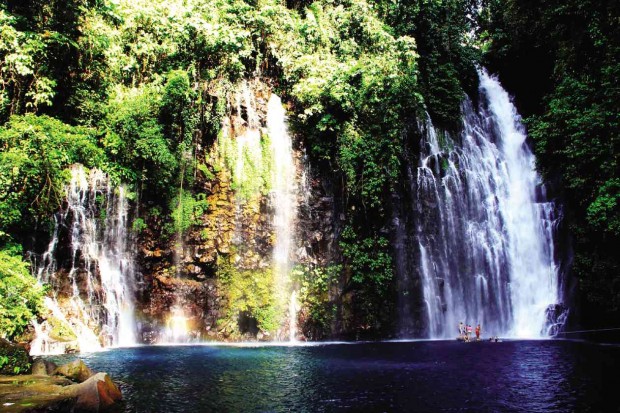
TOURISTS spend their leisure time during summer in the cool, blue natural lagoon of Tinago (hidden) falls in the hinterland village of Robocon, Linamon town in Lanao del Norte. Richel V. Umel
LANAO DEL NORTE—The towering waterfalls of Tinago in the village of Robocon in Linamon town here adapts the literal meaning of its moniker in the local language—a hidden natural treasure that can be reached by descending some 500 steps in a ravine-like terrain to be regaled by its beauty.
Just outside Iligan City, the falls is the main tourist attraction of the province but it also serves as a water source for residents near the area.
“The importance of Tinago falls in our lives is what prompted us to take active part in protecting the area and the watershed that surrounds it,” said Rodrigo Cantina, president of the Tinago Bantay Gubat Livelihood Association.
So when the Department of Agriculture’s Mindanao Rural Development Program (MRDP) introduced its natural resources management (NRM) project, the association took the cudgels of conservation into their own hands.
“In partnership with our local government, we implemented an agro-forestry project that allowed us to plant around 16,000 tree seedlings in 12 hectares of land surrounding the Tinago falls area,” Cantina said.
Fruit trees
Aside from forest trees like mahogany, narra, lawaan and mangium, he said they also planted fruit trees like durian, rambutan, mangosteen and lanzones.
The P2.3-million NRM project also included the construction of a nursery for the fruit trees, water system and reservoir.
“Through the agro-forestry project, the residents learned to practice a more diverse, productive and sustainable land use system,” Michaela Gorrero, municipal planning and development officer and NRM focal person, said.
The project also helps conserve the Tinago falls by attaining cleaner water through reduced nutrient and soil runoff, she added.
The Bantay Gubat group also received trainings on NRM from MRDP and the Department of Environment and Natural Resources particularly on forest management.
As chair, Cantina supervises the maintenance of the conservation area including ensuring that the fruit trees have fertilizer inputs every six months. “We are expecting these trees to bear fruit within the year and we are looking at selling these to sustain our livelihood,” he said.
Store
The group has also established a sari-sari store near the tourist site’s entrance with shares from individual members providing for the start-up capital and local government unit support for the construction of the store’s structure.
“With our involvement in the project, we did not only increase our awareness in managing our natural resources well but we realized that all of us can be part of the development process,” he said.
Another NRM project was also implemented in the village of Napo focusing on riverbank stabilization. Napo villagers formed a people’s organization that led in educating and building their capacity in environmental management and climate change mitigation.
Covering a 10-meter-by-5-kilometer stretch of Larapan River, the riverbank stabilization project adopted a bio-engineering planting technique using a combination of fast-growing species, forest trees and fruit trees, including bamboo and mangroves.
According to Gorrero, plans are underway to replicate what has been done to the Larapan riverbank to the Linamon River.
“The Linamon communities have realized the value of nurturing nature not only for their protection but for future generations to enjoy,” she said.
Jay M. Rosas is the information and advocacy specialist of the Philippine Rural Development Project, a P27.5-billion World Bank project implemented by the Department of Agriculture, national government and local government units. It is an upscaled version of the Mindanao Rural Development Program, which was completed last December 2014.